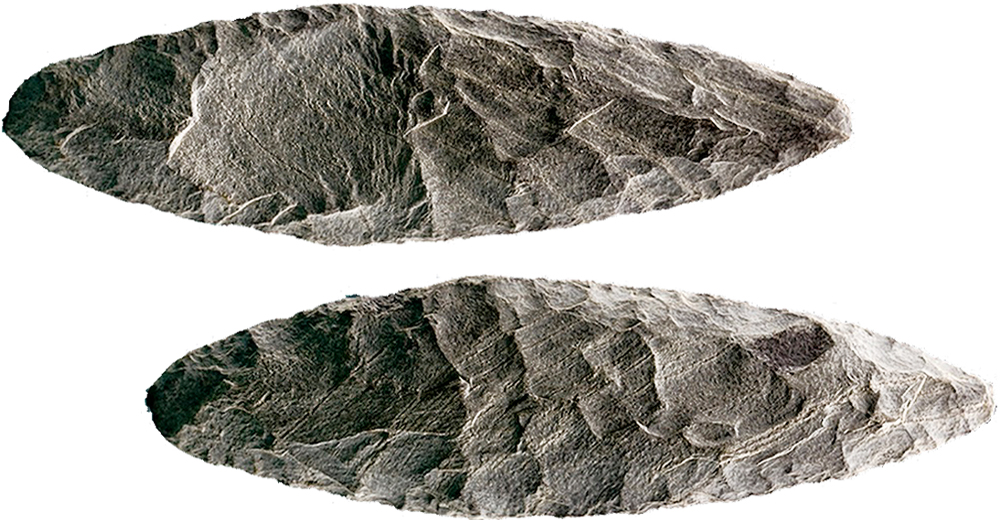


An online article by Tia Ghose on www.livescience.com entitled Fisherman Pulls Up Beastly Evidence of Early Americans describes the flaked blade discovered in the Chesapeake Bay.

The stone tool was recovered with a mastodon skull , and they show evidence of weathering in open air, then saltwater marshes, and finally the ocean. Since sea levels rose significantly some 14,000 years ago, it suggests that the tool was made at least that long ago, and therefore this stretch of the Atlantic Coast would have been occupied.
This may be evidence, even though the origins of these discoveries cannot be categorically proven, that North America was occupied thousands of years before people from the so-called Clovis culture, widely thought to be the first settlers of North America and the ancestors of all living Native Americans. Some researchers believe the first Americans crossed the Bering Strait from Siberia about 15,000 years ago and quickly colonized North America. Artifacts from these ancient settlers established the the Clovis culture after one of their archaeological sites in Clovis, New Mexico. The Chesapeake Bay discovery supports another hypothesis, as proposed by Bruce A. Bradley of Exeter University and Dennis Stanford, an archaeologist with the Smithsonian Institution in Washington, D.C., who has analyzed the find.
By measuring the fraction of radioactive carbon isotopes (elements of carbon with different numbers of neutrons), Stanford's team found that the mastodon tusk was more than 22,000 years old.
Moreover, the deft flint-knapping technique used to make the tool was similar to that found in Solutrean tools which were made in Europe between 22,000 and 17,000 years ago.
To Stanford and his colleagues, the discovery suggests that people lived along the East Coast more than 14,000 years ago - potentially thousands of years before the Clovis culture emerged there. These first American colonizers therefore would have crossed the Atlantic Ocean from Europe in what is called the Solutrean hypothesis.
The Iberian lithic connection is also supported by the mitochondrial genetic marker known as haplogroup mtDNA X, found in pre-Columbian eastern North America, with what appears to have pre-Columbian origins in - among other neighbouring regions - western Europe. The Solutrean hypothesis describes a 1600 mile polar front ice bridge of an adaptable sea-voyaging culture that exploited the marine environment.
http://www.bradshawfoundation.com/books/across_atlantic_ice.php
http://www.bradshawfoundation.com/america/clovis_first/index.php
Comment
by Bradshaw Foundation
Monday 04 December 2023
by Bradshaw Foundation
Friday 30 June 2023
by Bradshaw Foundation
Thursday 06 April 2023
by Bradshaw Foundation
Thursday 24 November 2022
by Bradshaw Foundation
Tuesday 27 September 2022
by Bradshaw Foundation
Thursday 08 September 2022
by Bradshaw Foundation
Tuesday 19 July 2022
by Bradshaw Foundation
Monday 06 June 2022
by Bradshaw Foundation
Friday 11 March 2022
by Bradshaw Foundation
Wednesday 02 March 2022
by Bradshaw Foundation
Thursday 26 August 2021
by Bradshaw Foundation
Monday 16 August 2021
by Bradshaw Foundation
Tuesday 06 July 2021
by Bradshaw Foundation
Thursday 06 May 2021
by Bradshaw Foundation
Thursday 06 May 2021
by Bradshaw Foundation
Tuesday 16 March 2021
by Bradshaw Foundation
Monday 04 December 2023
by Bradshaw Foundation
Friday 30 June 2023
by Bradshaw Foundation
Thursday 06 April 2023
by Bradshaw Foundation
Thursday 24 November 2022
by Bradshaw Foundation
Tuesday 27 September 2022
by Bradshaw Foundation
Thursday 08 September 2022
by Bradshaw Foundation
Tuesday 19 July 2022
by Bradshaw Foundation
Monday 06 June 2022
by Bradshaw Foundation
Friday 11 March 2022
by Bradshaw Foundation
Wednesday 02 March 2022
by Bradshaw Foundation
Thursday 26 August 2021
by Bradshaw Foundation
Monday 16 August 2021
by Bradshaw Foundation
Tuesday 06 July 2021
by Bradshaw Foundation
Thursday 06 May 2021
by Bradshaw Foundation
Thursday 06 May 2021
by Bradshaw Foundation
Tuesday 16 March 2021
Friend of the Foundation











